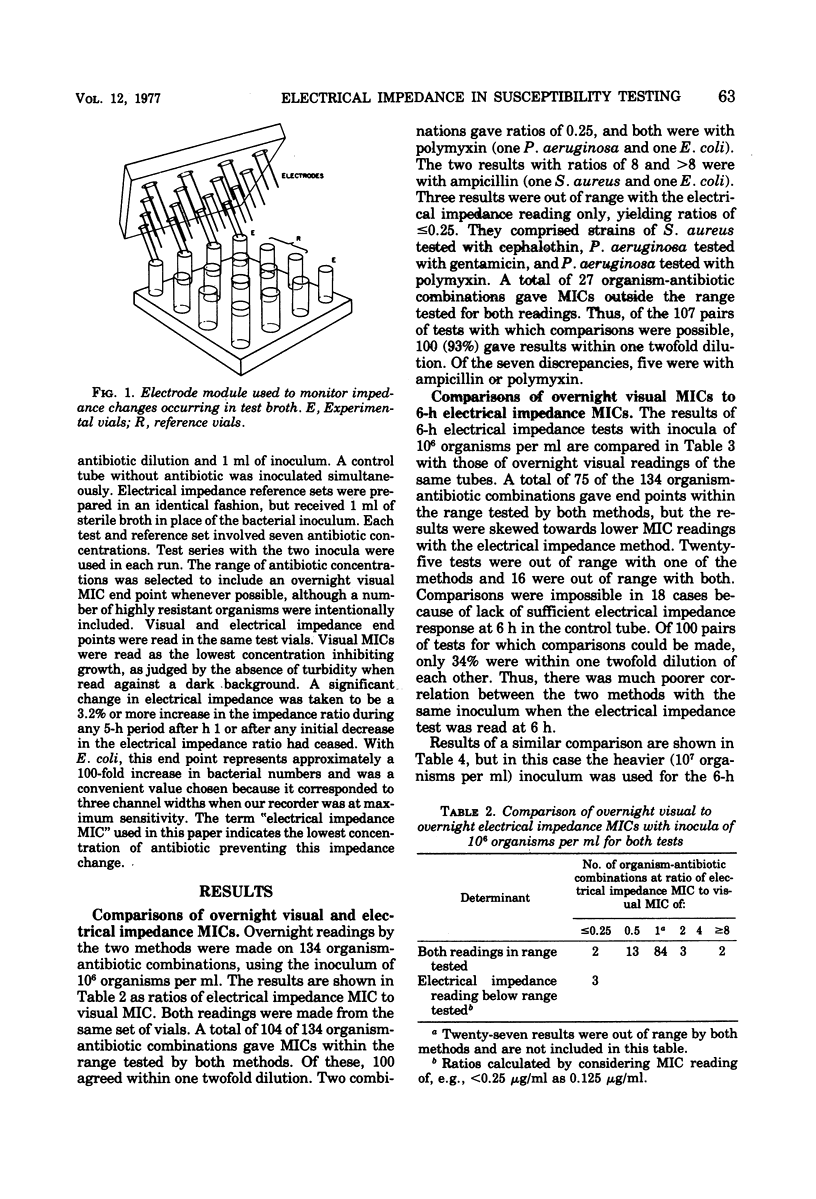Abstract
Electrical impedance changes in the medium were studied during traditional broth dilution tests. Tests involved clinical isolates of Escherichia coli, Staphylococcus aureus, Pseudomonas aeruginosa, Enterobacter sp., Klebsiella, and enterococcus and ten antibiotics. Minimal inhibitory concentration (MIC) values from overnight visual readings were compared with MIC values determined from electrical impedance end points, using inocula of 106 organisms per ml. Ninety-three percent of the results were within one twofold dilution of each other. When the impedance end point was determined at 6 h, this correlation was lowered to 34%. By increasing the initial electrical impedance inoculum 10-fold, the correlation between the 6-h impedance MIC and the overnight visual MIC was improved to 74%. Ampicillin, tetracycline, and polymyxin E results accounted for most discrepancies. Continuous monitoring of impedance changes suggested that better correspondence could be obtained by adjusting the end point criteria for the 6-h impedance MIC with different antibiotics. Electrical impedance methods for reading bacterial end points in automated clinical laboratory instruments appear promising.
Full text
PDF





Selected References
These references are in PubMed. This may not be the complete list of references from this article.
- Isenberg H. D., Reichler A., Wiseman D. Prototype of a fully automated device for determination of bacterial antibiotic susceptibility in the clinical laboratory. Appl Microbiol. 1971 Dec;22(6):980–986. doi: 10.1128/am.22.6.980-986.1971. [DOI] [PMC free article] [PubMed] [Google Scholar]
- Kagan R. L., Schuette W. H., Zierdt C. H., MacLowry J. D. Rapid automated disgnosis of bacteremia by impedance detection. J Clin Microbiol. 1977 Jan;5(1):51–57. doi: 10.1128/jcm.5.1.51-57.1977. [DOI] [PMC free article] [PubMed] [Google Scholar]
- Lampe M. F., Aitken C. L., Dennis P. G., Forsythe P. S., Patrick K. E., Schoenknecht F. D., Sherris J. C. Relationship of early readings of minimal inhibitory concentrations to the results of overnight tests. Antimicrob Agents Chemother. 1975 Oct;8(4):429–433. doi: 10.1128/aac.8.4.429. [DOI] [PMC free article] [PubMed] [Google Scholar]
- Thornsberry C., Gavan T. L., Sherris J. C., Balows A., Matsen J. M., Sabath L. D., Schoenknecht F., Thrupp L. D., Washington J. A., 2nd Laboratory evaluation of a rapid, automatic susceptibility testing system: report of a collaborative study. Antimicrob Agents Chemother. 1975 Apr;7(4):466–480. doi: 10.1128/aac.7.4.466. [DOI] [PMC free article] [PubMed] [Google Scholar]
- Ur A., Brown D. F. Impedance monitoring of bacterial activity. J Med Microbiol. 1975 Feb;8(1):19–28. doi: 10.1099/00222615-8-1-19. [DOI] [PubMed] [Google Scholar]
- Wyatt P. J. Identification of bacteria by differential light scattering. Nature. 1969 Mar 29;221(5187):1257–1258. doi: 10.1038/2211257a0. [DOI] [PubMed] [Google Scholar]


